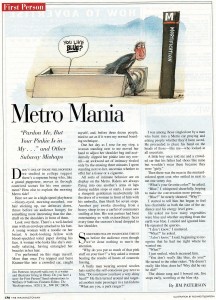The third party
The Internet is very involved in our relationships, but what’s it up to?
By Jim Paterson
Americans are on their phones nearly a third of their waking hours and texting much more often than talking. Email has replaced letter writing and of the 30 kids in any classroom, probably only three aren’t on social media regularly.
When the International Center for Media and the Public Agenda researchers asked 200 students to avoid electronic media for one day, the comments were telling: “I clearly am addicted and the dependency is sickening,” said one student. “I felt quite alone and secluded,” another said. “Although I go to a school with thousands of students, the fact that I was not able to communicate with anyone via technology was almost unbearable.”
Despite all that involvement, we often blame Facebook or online games for failing family connections and poor grades, we are suspicious of dating sites, and we see a string of social and emotional ills – from pornography addiction and ADHD to depression and infidelity – as being fed by online communications.
So, can the three of us get along? Probably most of the time, researchers say.
“The Internet sits side-by-side with offline relationships, weaving in and out of them,” says. Amanda Lenhart, a senior researcher at Pew Research Center, which has done extensive research on the topic. “These spaces are hard to interpret, but generally they are making things better for us.”
Lenhart and other researchers say while it has its pitfalls, the Web can renew old relationships, create new ones – and can build the good ones we have. Perhaps, they say, the Internet has not so much changed things as given our relationships a new platform where they can develop.
The first concerns…
About 30 years ago – 10 years before “You’ve got mail” and 20 years before Facebook – some pioneers in computer science at Carnegie Mellon University wanted to examine one facet of the Internet that not many people had thought of yet but today isn’t far from our minds: how it changes the way we connect with each other.
The new Human-Computer Interaction Institute had hired Robert Kraut, a pioneer in Internet communication, whose research initially suggested that while only about five percent of us we were using it in the mid-90’s, the Internet was likely to become a dominant communications tool. “We understood that communications is key to relationships and happiness, and it appeared communications might go online,” he says.
Kraut and a team of researchers in 1998 gave about 100 families computers and tracked their behavior in a well-publicized study that asked “Internet Paradox. A Social Technology That Reduces Social Involvement and Psychological Well-Being?” And the response to that query seemed to be “yes”.
“For our purposes, the most important finding is that greater use of the Internet was associated with subsequent declines in family communication.” the study concluded, also noting that it seemed to narrow one’s social circle and increase loneliness and depression. Others research supported those views as did books like “Silicon Snake Oil” by Clifford Stoll and articles like one in the New York Times in 1998 entitled “Sad, Lonely World Discovered in Cyberspace”.
Other research was suggesting that online communications lacked the “bandwidth” of traditional face-to-face communications, producing a “deindivuating effect”, along with self-centered and “socially unregulated” behavior” and isolation, according to John Bargh and Katelyn McKenna in their 2004 article in The Annual Review of Psychology titled “The Internet and Social Life”.
It may have been that early research – and our worry about something so invasive an unknown – that gave us the early impression the Internet was dangerous to relationships, Bargh and McKenna say.
“It has been vilified as a powerful new tool for the devil, awash in pornography, causing users to be addicted to hours each day of “surfing” – hours during which they are away from their family and friends, resulting in depression and loneliness for the individual user, and further weakening neighborhood and community ties,” they reported. “Some welcome it as a panacea while others fear it as a curse, but all would agree that it is quite capable of transforming society.”
But attitudes changed
Patti Valkenburg and Jochen Peter, writing in 2009 about “Social Consequences of the Internet for Adolescents”, said newer research was finding other results. “Whereas several studies in the 1990s suggested that Internet use is detrimental, recent studies tend to report opposite effects,” the two wrote in Current Directions in Psychological Science.
In The “Internet Paradox, revisited” in 2002, Kraut also explained that follow-up studies of his computer users found less concern about depression or loneliness , and in “Growing Closer on Facebook” in 2013, he studied more than 3,600 social media users to find out how the Internet fit into “ecology of communications” and the results were also more positive.
“.”
Kraut explains that while we may not need to communicate online with our closest friends and family, more frequent online connections “make us closer”. “Having Facebook communications seems to boost psychological well being and improve strong relationships,” he says, noting that it probably also reduces the likelihood of depression.
In our less significant online acquaintances the communications does less, but keeps them active. “Sometimes,” he says, “it helps the relationship and how we feel, to be in touch and simply know what is happening with someone. The Internet makes this easier.”
What he calls “broadcast” connections online are less likely to improve well being, and browsing without communicating may be damaging because it can makes some feel left out or envious of what another person has, a result that has been supported by two recent studies in ScienceDaily by University of Houston researcher Mai-Ly Steers. She found “people who spent more time on Facebook reported higher depressive symptoms due to social comparisons”.
In the end, Kraut says, online relationships are very much like the ones we have always had – though the platform has changed. “It is a matter of degrees. “Writing a personal message or a text is different than ‘liking’ something or responding to a simple birthday announcement on Facebook. It’s like the difference between a phone call or a personal note and a Hallmark card with just a signature.”
Another way of looking at it, according to Bargh and McKenna, is by examining the purpose of the communication along with the means. “The evidence suggests that while the effects are largely dependent on the particular goals that users bring to the interaction – such as self-expression, affiliation, or competition – they also interact in important ways with the unique qualities of the Internet communication situation.”
Less worry about damage
Those ideas have been supported by other studies, including work by Michael Chan, a communications professor at the Chinese University of Hong Kong, who, wrote “Mobile Phones and the Good Life: Examining the Relationships Among Mobile Use, Social Capital and Subjective Well-being” in 2013 for the journal New Media and Society.
Chan found cellphone use is “positively related to various indicators of subjective well-being and bonding, but that activities where users simply sought information or passed time had a negative effect.”
“With Internet connectivity and the mobile phone, individuals have perpetual connectivity with others, affording them the ability to develop and maintain meaningful relationships unbound by time or location and obtain and provide social support,” Chan said.
A 2010 study, “Internet Use and Psychological Well-being: A Meta-Analysis” appearing in the journal Cyberpsychology, Behavior, and Social Networking, summarized 43 studies with more than 21,00 participants. The author, Chiungjung Huang, a researcher at National Changhua University of Education in Taiwan, concluded that communications online created “only a small detrimental effect on psychological well-being.”
The research that Huang evaluated suggested online communication increases community involvement and face-to-face contact with friends, and improves long distance relationships, family relationships, the quality of life for the elderly and connections for lonely teens. Lenhart and colleagues at Pew also recently found about three quarters of adult Internet users say it had a positive effect on their romantic relationship.
Despite that, some experts say we don’t yet know the effect, and there are reasons for concern.
“It is here to stay, and somehow we adjusted to the telephone and the television – so our brains will need to figure this out too,” says Ramani Durvasula, a psychologist who works with couples and professor at California State University, Los Angeles. “These advances have been so fast, and they’re affecting all ages, especially kids whose brains are still developing. The jury is out on how it will impact neurodevelopment and emotions.”
A damaging distraction?
One way Internet communications differs from other communications methods is its mobility – with cellphones. Durvasula says we joke about being on our phones excessively, but there is a real danger for romantic partners and parents, noting she sees “chronic distraction” with her clients.
“Too many couples at dinner stare at their cellphones rather than at their dining companion,” she says. “Being in the same room no longer means getting and keeping the other person’s attention. In fact, we may give our ‘A game’ to the people on social media and not those right in front of us.” She also worries that distracted parents are “missing a critical developmental window and not taking enough time to teach children key tools of empathy, compassion, and emotional regulation.”
Lenhart says that increasingly couples complain about such distraction. Her study also showed that 25 percent found their partner distracted by a cellphone and a third of them reported it resulted in an argument. The numbers are much higher for 18- to-29-year-olds, with almost half saying their partner has been distracted.
Another 2013 report by
Some therapists suggest that couples should set boundaries for Internet use, and research by Aaron Norton and Joyce Baptist in Cyberpsychology: the Journal of Psychosocial Research on Cyberspace, suggests “while there appears to be some set of rules and boundaries that apply to offline relationships, it is unclear how or if these rules apply to Internet behaviors”.
“The act of sharing information such as passwords to social networking sites can be reassuring to one’s partner and send the message that one has nothing to hide,” their study found. “Curbing flirtatious communication can be construed as an act of fidelity thereby helping to maintain the relationship.”
Quality control
Lenhart worries that communications online is confusing, and can lead to misunderstanding, uncertainty or jealousy. “There is often ambiguity – even about a picture. It might seem totally innocent to a person who posted it, but have an entirely different meaning to someone else and cause conflict”.
And we also might be avoiding healthy conflict, says Alex Lickerman, author of the book “The Undefeated Mind: On the Science of Constructing an Indestructible Self”.
“We relate differently online,” he says. “For instance, it blocks us from registering the negative emotional responses a confrontation might engender, which provides us the illusion we’re not really doing harm.”
Psychologist Linda Bloom, who works with couples in Santa Cruz, CA, is concerned about “ghosting”, where people disappear from relationships quickly and entirely, which is amplified online because it is so complete and so quick. A recent study showed that half of us have been ghosted – and half have done it.
“It’s very painful for the person left behind,” says Bloom. “I’m concerned that large numbers will isolate as a result of feeling betrayed, or may end up being the one who does the ghosting.”
Jennice Vilhauer, an author and director of the a therapy program at Emory University in Atlanta, in a recent Psychology Today article on ghosting says that a “lack of social connections to people who are met online means there are less social consequences to dropping out of someone’s life”.
“The more it happens, either to themselves or their friends, the more people become desensitized to it and the more likely they are to do it to someone else.”
While early ideas about online communications being “impoverished” have been disputed, Lickerman nonetheless also believes communications online is deficient, and is particularly worried about young people, more than half of whom now say they would prefer to communicate online. “Not using or losing the ability to read social cues, which should develop in adolescence, will change us fundamentally.” Successful relationships involve reading and understanding those subtle cues, he says.
Not the end
The Internet also can unfortunately keep a connection alive for one party when a relationship has ended, says Elias Aboujaoude, a Stanford psychiatrist and author of “Virtually You: The Dangerous Powers of the e-Personality”.
“
Durvasula agrees. “Clients are becoming destabilized by social media, especially in the wake of a relationship breakup when they will obsessively monitor a former partner’s behavior and have to mourn and re-mourn a loss.”
Research by British psychologist Tara Marshall shows two-thirds of Facebook users checked on a former partner, which, she says, “is associated with poorer emotional recovery and personal growth following a breakup.”
—-
sidebar
Making a match
More than one-in-four young people use online dating sites and a study by Pew has found online dating no longer has the stigma it once did. A survey of 19,000 people who married between 2005 and 2012 found that 35 percent met online, about half through an online dating site.
Researchers have generally found that the results on social media were mixed and that that Facebook made meeting people easier but was both a blessing and a curse to romantic relationships.
“Beyond the stages of initiating and experimenting it seems that Facebook often becomes a burden to users in romantic relationships, said researchers in the 2013 report “The Role of Facebook in Romantic Relationship Development” appearing in the Journal of Social and Personal Relationships.
The study found that courting online helps people sort through and connect with potential partners faster but “many aspects of online dating do not appear to improve romantic outcomes and might even undermine them”.
Research by Aditi Paul in Cyberpsychology, Behavior, And Social Networking in 2014 reports people who date online were more likely to have romantic relationships, but less likely to get married. Paul also showed that the breakup rates for married and unmarried couples was higher if they met online.
In addition, Monica Whitty, a professor of contemporary media at Britain’s University Of Leicester, says that online dating has increased jealousy and mistrust in many cases, and made relationships more fragile.
“Technology has impacted the courtship ritual,” says Durvasula. “It provides an illusion of a large swath of options, which may make people more likely to keep looking for a ‘perfect’ partner or focus on superficial characteristics that are easier to communicate online. It replaces a deeper level connectivity that is more meaningful and important in the long run.”
Jim Paterson is a writer living in Lewes, DE.




